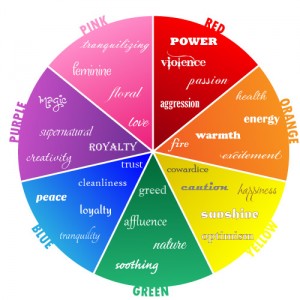What’s in a Color? How to Use Color Symbolism in Your Stories
I love colors. I’ll say it over and over again: I love colors! They’re beautiful. They’re stimulating. Sometimes I even think they’re magical. I love everything about them, from the power they have to evoke emotions to the subtle yet distinct differences they make in a work of art. But my favorite thing about colors is their symbolism, the way they can be used to hide secrets and hint at details of a bigger picture without drawing focus away from the story at hand.

Color wheel explaining the meanings of colors
(Source: Sweet Dreamz Design)
It’s simple enough to use colors in visual art, but what about in writing? Challenging as it may seem, I believe it is possible to create symbolism with words, such as when describing color schemes of character outfits and settings. Color symbolism has fascinated me for as long as I can remember, and while it would take an entire book (or series of books) to get into it all, I’d like to at least scratch the surface today with some of the basics I’ve picked up throughout my experience researching and implementing meaningful colors in my stories. You may want to consider these tips the next time you set a scene; they can help add a vivid new layer to your story! Enjoy!
 Red – Red is a bold and passionate color, often symbolizing such strong ideas and images as courage, fire, power, and violence. It’s a color that demands attention, which is why it’s commonly used to signify danger. Use red for passionate or aggressive characters, or for any sort of intense scene, whether it’s the heat of love or the violence of war.
Red – Red is a bold and passionate color, often symbolizing such strong ideas and images as courage, fire, power, and violence. It’s a color that demands attention, which is why it’s commonly used to signify danger. Use red for passionate or aggressive characters, or for any sort of intense scene, whether it’s the heat of love or the violence of war.
 Orange – Not quite passionate and not quite joyful, orange is a middle ground between red and yellow. It symbolizes energy and creativity, and is used in psychology to stimulate enthusiasm and determination. Use orange for adventurous or creative characters, or when you want to paint some vibrant warmth into a scene.
Orange – Not quite passionate and not quite joyful, orange is a middle ground between red and yellow. It symbolizes energy and creativity, and is used in psychology to stimulate enthusiasm and determination. Use orange for adventurous or creative characters, or when you want to paint some vibrant warmth into a scene.
 Yellow – Yellow is the two-sided coin of colors. On the one hand, it symbolizes happiness, optimism, sunshine, and friendship. On the other hand, it can also stand for cowardice, illness, hazard, and deceit. Golden shades represent wealth and luxury. Use yellow when you want to add hints of joy or caution to a scene. For the best effect, I recommend using yellow ambiguously, such as for characters who seem jubilant and optimistic on the outside but who are fearful or deceitful on the inside.
Yellow – Yellow is the two-sided coin of colors. On the one hand, it symbolizes happiness, optimism, sunshine, and friendship. On the other hand, it can also stand for cowardice, illness, hazard, and deceit. Golden shades represent wealth and luxury. Use yellow when you want to add hints of joy or caution to a scene. For the best effect, I recommend using yellow ambiguously, such as for characters who seem jubilant and optimistic on the outside but who are fearful or deceitful on the inside.
 Green – Think of green and you’re sure to picture beautiful scenes of nature, complete with lush vegetation as far as the eye can see. Indeed, green is the color of the environment, and it represents such ideas as youth, fertility, health, and rebirth. Abstractly, it also symbolizes jealousy and good luck. Use green for characters associated with natural themes such as environmentalism or the practice of healing, or to hint at fortune or envy in relationships.
Green – Think of green and you’re sure to picture beautiful scenes of nature, complete with lush vegetation as far as the eye can see. Indeed, green is the color of the environment, and it represents such ideas as youth, fertility, health, and rebirth. Abstractly, it also symbolizes jealousy and good luck. Use green for characters associated with natural themes such as environmentalism or the practice of healing, or to hint at fortune or envy in relationships.
 Blue – Blue is my favorite color because it represents all my favorite things. It’s a color that symbolizes intelligence, tranquility, trust, and loyalty. In nature, it’s associated with the sky and the sea, and different shades from turquoise to navy can be used to signify sophistication, knowledge, and integrity. Use blue for characters who are more intellectual than emotional, and for settings fitting an atmosphere of calm and authority.
Blue – Blue is my favorite color because it represents all my favorite things. It’s a color that symbolizes intelligence, tranquility, trust, and loyalty. In nature, it’s associated with the sky and the sea, and different shades from turquoise to navy can be used to signify sophistication, knowledge, and integrity. Use blue for characters who are more intellectual than emotional, and for settings fitting an atmosphere of calm and authority.
 Purple – Purple is the color of royalty, and has long represented such themes as nobility, wisdom, honor, and extravagance. Being a relatively rare color in nature, it is often associated with mystery and magic. Lighter shades such as lavender also convey grace and elegance. Use purple as a motif for regal or arrogant characters, mysterious settings, and storylines brimming with fantasy.
Purple – Purple is the color of royalty, and has long represented such themes as nobility, wisdom, honor, and extravagance. Being a relatively rare color in nature, it is often associated with mystery and magic. Lighter shades such as lavender also convey grace and elegance. Use purple as a motif for regal or arrogant characters, mysterious settings, and storylines brimming with fantasy.
 Pink – A soft complement to the bold red, pink is the color that most famously signifies love and romance. Strongly associated with femininity, it represents tenderness, caring, and acceptance. I myself tend to associate the color pink with flowers. Use pink to add a soothing or feminine quality to a scene, or to signify elements of a romantic subplot.
Pink – A soft complement to the bold red, pink is the color that most famously signifies love and romance. Strongly associated with femininity, it represents tenderness, caring, and acceptance. I myself tend to associate the color pink with flowers. Use pink to add a soothing or feminine quality to a scene, or to signify elements of a romantic subplot.
 Brown – Brown is well known as an earth tone, and as such tends to represent stability. Common ideas associated with the color brown include simplicity, comfort, and endurance. Use brown when you want to convey a sense of plainness or tenacity in a scene without having to resort to the blatant dullness of gray.
Brown – Brown is well known as an earth tone, and as such tends to represent stability. Common ideas associated with the color brown include simplicity, comfort, and endurance. Use brown when you want to convey a sense of plainness or tenacity in a scene without having to resort to the blatant dullness of gray.
 Gray – The dull middle ground between white and black, gray is most commonly associated with boredom and depression. On the positive side, it also stands for security, modesty, practicality, and reliability. Use gray for conservative characters or when you want to create a colorless air for a particular setting.
Gray – The dull middle ground between white and black, gray is most commonly associated with boredom and depression. On the positive side, it also stands for security, modesty, practicality, and reliability. Use gray for conservative characters or when you want to create a colorless air for a particular setting.
 White – White is the international color of peace, and is often regarded as a symbol of light, purity, and faith. Some even go as far as to associate it with perfection. Note that white takes on a different meaning in Eastern cultures, where it’s associated with death and mourning. Use white when you want to convey innocence in your characters and cleanliness in your settings, or when you want to create strong religious symbolism in your scenes.
White – White is the international color of peace, and is often regarded as a symbol of light, purity, and faith. Some even go as far as to associate it with perfection. Note that white takes on a different meaning in Eastern cultures, where it’s associated with death and mourning. Use white when you want to convey innocence in your characters and cleanliness in your settings, or when you want to create strong religious symbolism in your scenes.
 Black – The exact opposite of white, black represents everything that its counterpart doesn’t. Darkness, evil, and death are themes commonly associated with black, but it can also stand for austerity, formality, style, and sexuality. Arguably the most powerful color of all, black has a long history of symbolizing strongly opposed ideas on the spectrum of good and evil. Use black to convey depth in your characters or to add dark themes to a scene. For best results, combine it with other colors to create interesting contrasts of ideas in your stories.
Black – The exact opposite of white, black represents everything that its counterpart doesn’t. Darkness, evil, and death are themes commonly associated with black, but it can also stand for austerity, formality, style, and sexuality. Arguably the most powerful color of all, black has a long history of symbolizing strongly opposed ideas on the spectrum of good and evil. Use black to convey depth in your characters or to add dark themes to a scene. For best results, combine it with other colors to create interesting contrasts of ideas in your stories.
I hope you’ve enjoyed exploring the symbolism of color with me, and that you’ve picked up a few hints along the way! Have fun experimenting with the colors in your stories! Good luck, and thanks for reading!
Do you use color symbolism in your stories? Which colors are your favorites?
References and Further Reading


Recent Comments